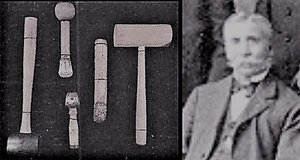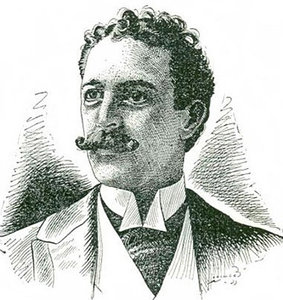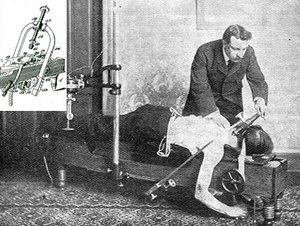The story goes that Presbyterian minister Reverend Samuel Weed provided D.D. Palmer with a list of Greek words from which to pick the name of his new healing art. "Palmer looked them over and decided to use chiropractic from cheir, which means 'hand' in Greek, and praktos, meaning 'done.'"1 Similarly, Stephenson has defined chiropractic as "a philosophy, science and art of things natural; a system of adjusting the segments of the spinal column, by hand only, for the correction of the cause of dis-ease."2
 Figure 1. The members of the classes of the PSC from 1899 through 1901 along with Old Dad Chiro. Seated (L to R), O.G. Smith, D.D. Palmer and Thomas Storey. Standing (L to R), E.E. Sutton, B.J. Palmer, O.B. Jones and S.M. Langworthy. Photo courtesy Chiropractic History and the Association for the History of Chiropractic.
B.J. Palmer displayed a set of mallets and wooden chisels at the Palmer School of Chiropractic (PSC) that others had used to apply corrective forces to the spine, and said the following: "The above spine-sets and their drivers may be seen at the P.S.C. I do not approve of their use, as they do not come within done by hand."4
Figure 1. The members of the classes of the PSC from 1899 through 1901 along with Old Dad Chiro. Seated (L to R), O.G. Smith, D.D. Palmer and Thomas Storey. Standing (L to R), E.E. Sutton, B.J. Palmer, O.B. Jones and S.M. Langworthy. Photo courtesy Chiropractic History and the Association for the History of Chiropractic.
B.J. Palmer displayed a set of mallets and wooden chisels at the Palmer School of Chiropractic (PSC) that others had used to apply corrective forces to the spine, and said the following: "The above spine-sets and their drivers may be seen at the P.S.C. I do not approve of their use, as they do not come within done by hand."4
In spite of these facts, the profession has a history of methods in which the doctor's hands are supplemented with mechanical devices to assist in the correction of the chiropractic lesion. With that said, let's look at the history of the use of instruments to apply adjusting forces to the spine.
The Original Instrument Adjusters
Figure 1 is a composite picture of the PSC classes of 1899 through 1901. The two gentlemen on the far right were the first graduates of the PSC to utilize instruments to adjust the segments of the spine, in spite of the fact that their mentor did not believe it was appropriate practice under the umbrella of chiropractic methods.
 Figure 2. Thomas Storey, DO, DC and his mallets and wedges for adjusting cervical vertebrae. Photo courtesy Chiropractic History and the Association for the History of Chiropractic.
Thomas Storey, DO, DC (Figure 2) was a Canadian immigrant who practiced in Duluth, Minn., as a vitapathic physician (similar to a magnetic healer with some folk remedies thrown in the mix). Storey claimed to have attended McGill University Medical School in Montreal; however, there is no evidence to support that claim. He obtained his osteopathic degree from a diploma mill in Chicago, Ill. Class of 1901 at PSC with Solon Langworthy and E.E. Sutton, Storey told that he was only taught by D.D. Palmer to adjust thoracic and lumbar vertebrae. He developed what he called the mallet and wedge technique to adjust cervical vertebrae. He taught these methods to other Minnesotan chiropractors.5
Figure 2. Thomas Storey, DO, DC and his mallets and wedges for adjusting cervical vertebrae. Photo courtesy Chiropractic History and the Association for the History of Chiropractic.
Thomas Storey, DO, DC (Figure 2) was a Canadian immigrant who practiced in Duluth, Minn., as a vitapathic physician (similar to a magnetic healer with some folk remedies thrown in the mix). Storey claimed to have attended McGill University Medical School in Montreal; however, there is no evidence to support that claim. He obtained his osteopathic degree from a diploma mill in Chicago, Ill. Class of 1901 at PSC with Solon Langworthy and E.E. Sutton, Storey told that he was only taught by D.D. Palmer to adjust thoracic and lumbar vertebrae. He developed what he called the mallet and wedge technique to adjust cervical vertebrae. He taught these methods to other Minnesotan chiropractors.5
 Figure 3. Artist's rendering of Solon Massey Langworthy as he appeared circa 1904. Courtesy the author's private collection.
Solon Massey Langworthy, DO, DC6-7 was born and bred in Iowa. Like Storey, he had studied osteopathic methods prior to attending the PSC. In the early years of the profession he would become the principal rival of the Davenport Palmers and achieved a number of firsts in the profession:
Figure 3. Artist's rendering of Solon Massey Langworthy as he appeared circa 1904. Courtesy the author's private collection.
Solon Massey Langworthy, DO, DC6-7 was born and bred in Iowa. Like Storey, he had studied osteopathic methods prior to attending the PSC. In the early years of the profession he would become the principal rival of the Davenport Palmers and achieved a number of firsts in the profession:
- Establishing the first incorporated chiropractic school in the nation
- Establishing of the first systematic chiropractic school curriculum
- Publishing the first professional journal (Backbone)
- Publishing and co-authoring the first chiropractic textbooks (Modernized Chiropractic, Volumes I & II)
- First to patent technique modality devices
 Figure 4. The Langworthy adjusting table with built-in adjusting instrument. Note the U-shaped yoke with attached tubular screw fitted with a rubber stylus. This instrument was used by applying a pre-stress pressure by turning the screw until the desired sustained force was applied to the subluxated spinal segment and then a purcussive force could be applied by striking the end of the tubular screw with a rubber mallet. Drawing courtesy the author's private collection.
Upon his graduation from the PSC, Langworthy established a private practice in Cedar Rapids, Iowa, and built that practice into a bustling enterprise, earning an annual income that would equate to more than $230,000 in today's money.8
Figure 4. The Langworthy adjusting table with built-in adjusting instrument. Note the U-shaped yoke with attached tubular screw fitted with a rubber stylus. This instrument was used by applying a pre-stress pressure by turning the screw until the desired sustained force was applied to the subluxated spinal segment and then a purcussive force could be applied by striking the end of the tubular screw with a rubber mallet. Drawing courtesy the author's private collection.
Upon his graduation from the PSC, Langworthy established a private practice in Cedar Rapids, Iowa, and built that practice into a bustling enterprise, earning an annual income that would equate to more than $230,000 in today's money.8
In 1905 he submitted a patent to the United States Patent Office for what was titled a "surgical table."9 The table is really a chiropractic adjusting table with an adjusting instrument built into the cranial end of the device (Figure 3).
Langworthy explains the use of the adjusting instrument, called the "lateral tension device" in the patent itself:
 Figure 5. Solon Langworthy applies a pre-stress force to the subluxated vertebra of the patient by turning the tubular screw to advance it into the skin and overlying tissue of said vertebra. He could then strike the end of the tubular screw with a rubber mallet to apply a percussive force to the offending segment.
"In the use of the machine, the patient is placed in position, the head and feet secured as described, and then the body is extended by means of the stretching device. The spinal column is then tense and in suitable condition for the treatment of any particular vertebra so as to adjust it to a proper position. The lateral tension device is accordingly set so that the applicator will bear on the part in question, and at precisely the right angle. Then by slow pressure, as by turning of the screw, or a sudden thrust, as by striking the applicator rod with a rubber mallet, the faulty member is forced to a proper position."9
Figure 5. Solon Langworthy applies a pre-stress force to the subluxated vertebra of the patient by turning the tubular screw to advance it into the skin and overlying tissue of said vertebra. He could then strike the end of the tubular screw with a rubber mallet to apply a percussive force to the offending segment.
"In the use of the machine, the patient is placed in position, the head and feet secured as described, and then the body is extended by means of the stretching device. The spinal column is then tense and in suitable condition for the treatment of any particular vertebra so as to adjust it to a proper position. The lateral tension device is accordingly set so that the applicator will bear on the part in question, and at precisely the right angle. Then by slow pressure, as by turning of the screw, or a sudden thrust, as by striking the applicator rod with a rubber mallet, the faulty member is forced to a proper position."9
Figure 5 depicts Langworthy using his adjusting device on an actual patient.
Editor's Note: Part 2 of this article appears in the August 2019 digital edition and discusses upper-cervical instruments, along with Activator Methods Chiropractic Technique. The author notes that this is an abridged history of adjusting tools and does not include more recent innovations. Complete references accompany part 2 of this article.
Dr. Steve Troyanovich is the secretary of the Association for the History of Chiropractic. Contact him with questions and comments at
. The AHC has preserved the credible history of the profession as its sole mission through the publication of the scholarly journal, Chiropractic History. Stories such as this one may be accessed through the pages of the AHC's journal (www.historyofchiropractic.org).




